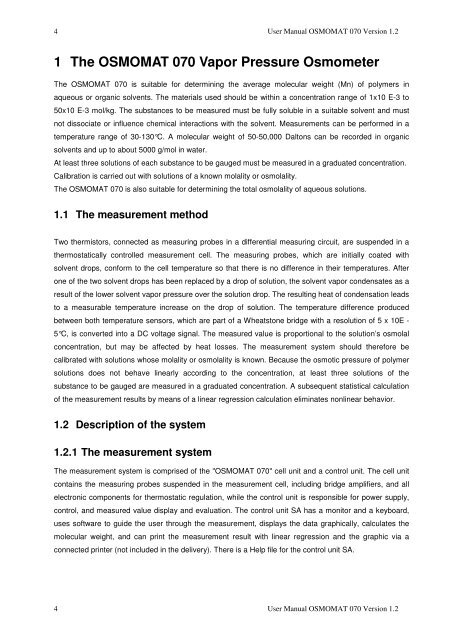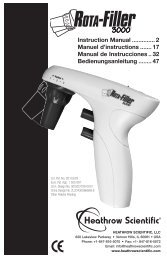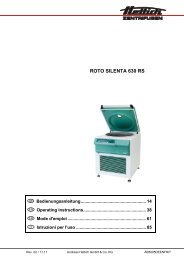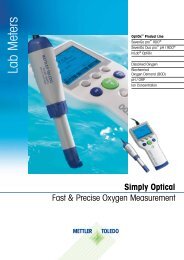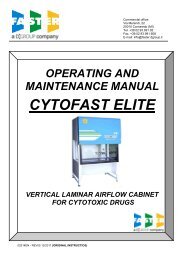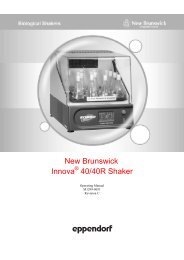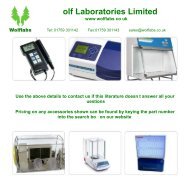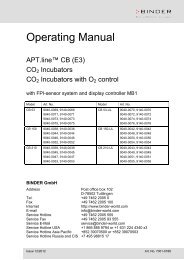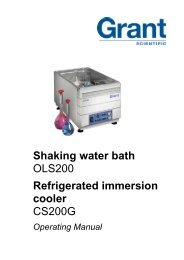1 THE OSMOMAT 070 VAPOR PRESSURE OSMOMETER ...
1 THE OSMOMAT 070 VAPOR PRESSURE OSMOMETER ...
1 THE OSMOMAT 070 VAPOR PRESSURE OSMOMETER ...
You also want an ePaper? Increase the reach of your titles
YUMPU automatically turns print PDFs into web optimized ePapers that Google loves.
4 User Manual <strong>OSMOMAT</strong> <strong>070</strong> Version 1.2<br />
1 The <strong>OSMOMAT</strong> <strong>070</strong> Vapor Pressure Osmometer<br />
The <strong>OSMOMAT</strong> <strong>070</strong> is suitable for determining the average molecular weight (Mn) of polymers in<br />
aqueous or organic solvents. The materials used should be within a concentration range of 1x10 E-3 to<br />
50x10 E-3 mol/kg. The substances to be measured must be fully soluble in a suitable solvent and must<br />
not dissociate or influence chemical interactions with the solvent. Measurements can be performed in a<br />
temperature range of 30-130°C. A molecular weight of 50-50,000 Daltons can be recorded in organic<br />
solvents and up to about 5000 g/mol in water.<br />
At least three solutions of each substance to be gauged must be measured in a graduated concentration.<br />
Calibration is carried out with solutions of a known molality or osmolality.<br />
The <strong>OSMOMAT</strong> <strong>070</strong> is also suitable for determining the total osmolality of aqueous solutions.<br />
1.1 The measurement method<br />
Two thermistors, connected as measuring probes in a differential measuring circuit, are suspended in a<br />
thermostatically controlled measurement cell. The measuring probes, which are initially coated with<br />
solvent drops, conform to the cell temperature so that there is no difference in their temperatures. After<br />
one of the two solvent drops has been replaced by a drop of solution, the solvent vapor condensates as a<br />
result of the lower solvent vapor pressure over the solution drop. The resulting heat of condensation leads<br />
to a measurable temperature increase on the drop of solution. The temperature difference produced<br />
between both temperature sensors, which are part of a Wheatstone bridge with a resolution of 5 x 10E -<br />
5°C, is converted into a DC voltage signal. The measured value is proportional to the solution’s osmolal<br />
concentration, but may be affected by heat losses. The measurement system should therefore be<br />
calibrated with solutions whose molality or osmolality is known. Because the osmotic pressure of polymer<br />
solutions does not behave linearly according to the concentration, at least three solutions of the<br />
substance to be gauged are measured in a graduated concentration. A subsequent statistical calculation<br />
of the measurement results by means of a linear regression calculation eliminates nonlinear behavior.<br />
1.2 Description of the system<br />
1.2.1 The measurement system<br />
The measurement system is comprised of the "<strong>OSMOMAT</strong> <strong>070</strong>" cell unit and a control unit. The cell unit<br />
contains the measuring probes suspended in the measurement cell, including bridge amplifiers, and all<br />
electronic components for thermostatic regulation, while the control unit is responsible for power supply,<br />
control, and measured value display and evaluation. The control unit SA has a monitor and a keyboard,<br />
uses software to guide the user through the measurement, displays the data graphically, calculates the<br />
molecular weight, and can print the measurement result with linear regression and the graphic via a<br />
connected printer (not included in the delivery). There is a Help file for the control unit SA.<br />
4 User Manual <strong>OSMOMAT</strong> <strong>070</strong> Version 1.2


